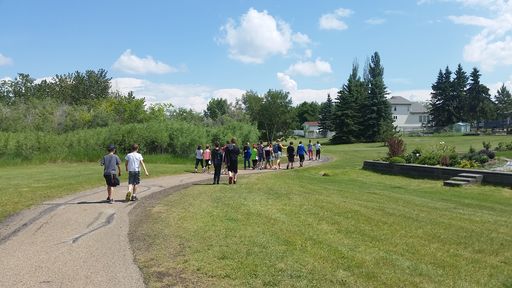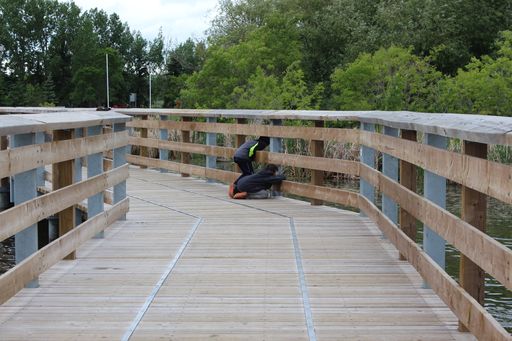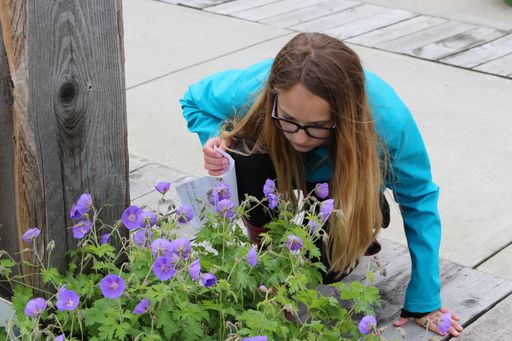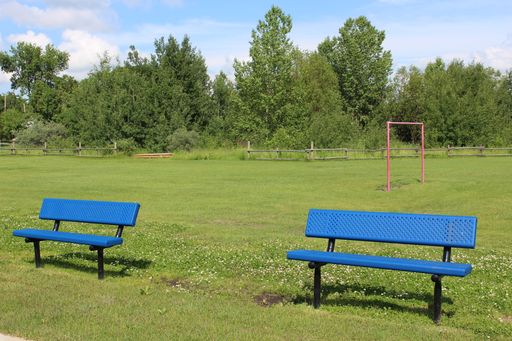In a previous article in this magazine, Bradford and Watt (2017) encouraged teachers to help students “hit the math trails.” Since that time, faculty, staff, and students in the Faculty of Education (Concordia University of Edmonton [CUE]) have engaged in a number of Math Trail activities aimed to support student learning. Beginning with their learning in the post-secondary classroom—undergraduate, after degree, and graduate-level courses—several CUE students (preservice and in-service teachers) have chosen to apply their understanding of Math Trails in their own school communities.
 Becoming Math Detectives
Becoming Math Detectives
Math Trails afford students opportunities to travel to and stop at designated sites (control points) along a route investigating and discovering the abundance of “math-related” information that exists throughout the environment (Bradford & Watt, 2017). For example, opportunities for students to discover the distance, height, surface area, shapes, etc., can be found throughout school and neighbouring environments. When students investigate and discover real-world shapes, patterns, numbers, data, symmetry and reflections, their eyes become wide open to the “math” existing in their world, leading to posing new queries, solving problems, and communicating discoveries in multiple ways (English, Humble & Barnes, 2010). Moreover, while becoming Math Detectives, Math Trails provide ways for teachers to demonstrate the effectiveness of cross-curricular connections (e.g., fusing science, math, and physical education).
This article has been written to share how Math Trails have been organized by three educators in their own school communities. Ultimately, we wish to impart a few practical strategies for teachers—at all educational levels—to plan for meaningful learning experiences through enjoyable, challenging, and developmentally appropriate Math Trails.
Math Trails for Student Learning
 When planning for Math Trail learning experiences, it is essential for teachers to note that there are no defined rules—Math Trails need only meet the learning context. If teachers are wondering where to begin, the answer can be to simply begin with one stop on a nearby trail or at a designated spot on the school grounds, and ensure each group has a clipboard, pencil, and activity sheet with predetermined questions related to the control points. Math Detectives can work in pairs or small teams to make the expedition manageable and to encourage “mathematical” communication (Richardson, 2004). In the following section, three educators share their experiences of planning for, implementing, assessing, and reflecting on Math Trails in their own school communities.
When planning for Math Trail learning experiences, it is essential for teachers to note that there are no defined rules—Math Trails need only meet the learning context. If teachers are wondering where to begin, the answer can be to simply begin with one stop on a nearby trail or at a designated spot on the school grounds, and ensure each group has a clipboard, pencil, and activity sheet with predetermined questions related to the control points. Math Detectives can work in pairs or small teams to make the expedition manageable and to encourage “mathematical” communication (Richardson, 2004). In the following section, three educators share their experiences of planning for, implementing, assessing, and reflecting on Math Trails in their own school communities.
MATH TRAILS: A Year-End Experience
Jennifer Kruse: Grade 5 Teacher; Graduate Student (CUE; MEd)
School: Preschool – Grade 6
Participants: Grade 5 (25 students)
During one of my Master of Education (MEd) courses, I had the opportunity to participate in a Math Trails activity. After our MEd cohort discussed the flexibility of Math Trails within our respective teaching environments, I immediately started to brainstorm ideas. I created a way to connect math learning outcomes to the school environment as a culminating end-of-year activity.
Process: During my designated planning time, I walked around the school grounds while reviewing the Grade 5 math learning outcomes. I created a variety of questions based on the school environment (e.g., playground, field, fenced wooded area, interior and exterior building) that would allow students to independently complete the tasks at each of the control points. Questions focused on estimation, observation, and calculation. Some questions required an additional clue, which was left with the librarian during office hours.
After a brief introduction and instruction, students were partnered up and asked to begin at specific points on the trail to avoid a large group of students moving together. Each student was provided with a Trail Guide and a pencil to record their own observations. Students were allotted 60 minutes to complete their Math Trails. As a whole group on the following day, we discussed each question and student observations. This sparked an interesting discussion about perspective, understanding/interpretation of the questions/clues, and “who got the right answer.”
Student Participation: Although there was a range of math ability and confidence among the students, they were all able to complete the majority of the activity. Some students required more assistance and usually asked their partners before asking the teacher, Educational Assistant (EA), and/or other staff members. Students requiring EA assistance to assist diverse learning needs completed slightly modified versions of Math Trail control points, and were partnered up as well.
 Observations: Overall, the Math Trails activity was quite interesting due to the interactions between students and within their environment. I avoided interjecting conversations or offering assistance as I wanted to allow their conversations and problem solving skills to influence their approach. What I was most impressed with was the follow-up discussion that involved all students; they each had a voice in the same math discussion. It didn’t matter the level of math they were working on, because they were all able to recall their personal experiences. While I was expecting to guide the conversation, they were using each other to provoke conversation and value their peers’ input. A small number of students were wondering about the exact answers to questions, however, to their disappointment, I did not have them. I explained that the purpose is not to have the correct answer but to recognize the different forms that math appears in throughout our everyday lives and how perspective can change from person to person.
Observations: Overall, the Math Trails activity was quite interesting due to the interactions between students and within their environment. I avoided interjecting conversations or offering assistance as I wanted to allow their conversations and problem solving skills to influence their approach. What I was most impressed with was the follow-up discussion that involved all students; they each had a voice in the same math discussion. It didn’t matter the level of math they were working on, because they were all able to recall their personal experiences. While I was expecting to guide the conversation, they were using each other to provoke conversation and value their peers’ input. A small number of students were wondering about the exact answers to questions, however, to their disappointment, I did not have them. I explained that the purpose is not to have the correct answer but to recognize the different forms that math appears in throughout our everyday lives and how perspective can change from person to person.
When I do this activity again, I will encourage students to use a device to take pictures for answers to clues and explain their thinking on paper. This will allow students to take their math approach one step further to “find something their teacher missed” and create their own question with a visual. Using a device may also assist students with their explanation of their understanding of the questions/clues.
MATH TRAILS: A Staff Team-Building Experience
Brenna Liddell: School Administrator; Graduate Student (CUE; MEd)
School: Grade 7 – 12
Participants: Approx. 60 staff members (teachers, support staff)
After being introduced to Math Trails and having an opportunity to participate in one during a graduate-level course at CUE, I chose to carry out a Math Trails activity with my staff at the beginning of the 2019 – 2020 school year. As part of a start-of-the-year team building activity, staff members were divided into small groups of 3 to 4. Although staff members were able to choose their own groups, it was satisfying to see how many of our more veteran staff reached out to new staff to ensure they were included and developed a sense of belonging (which we wish for all of our students).
After the groups were provided with instructions and clues, they were given a time limit and sent to complete the Math Trail activity. That said, we decided to include a few “fun” awards for top finishing groups—a “Team Spirit” award along with the Top 3 groups received small token prizes.
My initial observations were that all groups were quickly engaged in the task with a lot of different strategies being employed to problem solve at the control points. Although the conversations were very mathematically-based, one thing I appreciated was that I was able to hear how they were discussing various methods for solving the different math problems as I moved among the groups. The communication amongst group members was highly effective and supportive.
Group Comments: Throughout the Math Trail activity, I heard many group members mention the following:
• how what was provided to them could be easily adapted to suit their own grade-specific curricular outcomes
• how staff working in different grade levels and subject areas could collaborate to develop Math Trails for their students while incorporating cross-grade/cross-curricular activities
Closing Comments: Although I would not consider myself a Math Specialist, or someone who enjoyed math as a student, I was amazed at how some of our very strong Math Lead Teachers commented on what an excellent math-based activity this was for them to experience. Moreover:
• our Physical Education teachers loved that “physical movement” was fused with other curricular learning outcomes (e.g., math)
• the majority of staff stated that the Math Trail activity was a fun way to team-build at the beginning of the school year
• the conversations between individual groups, multiple groups and staff (as a whole) following the Math Trail activity revealed that multiple strategies were employed to solve the “math-based” problems at each control point
• it was interesting to hear how different groups solved each problem, with some groups using multiple strategies due to various “withingroup” ideas and the yearning to discover whose way was the “correct way”
• several staff members have shared that they chose to use the same or similar Math Trail activities with their own classes and/or plan to during the school year
 Overall, organizing a Math Trail staff team-building activity at the beginning of the school year was a positive, constructive, and enjoyable activity for our staff. As an icebreaker activity that afforded new and returning staff to positively engage with one another and an opportunity for people to get to know our school was a memorable learning experience for all. The activity was an excellent way to get staff members talking about math regardless of their teaching assignment. It was fun to hear my colleagues explaining how simple it is to connect math to other subject areas without much effort.
Overall, organizing a Math Trail staff team-building activity at the beginning of the school year was a positive, constructive, and enjoyable activity for our staff. As an icebreaker activity that afforded new and returning staff to positively engage with one another and an opportunity for people to get to know our school was a memorable learning experience for all. The activity was an excellent way to get staff members talking about math regardless of their teaching assignment. It was fun to hear my colleagues explaining how simple it is to connect math to other subject areas without much effort.
I would definitely encourage you to plan for a similar Math Trail staff team-building activity with your staff near the beginning of the school year. You will see the benefits of your efforts emerging throughout the school year!
 MATH TRAILS: A Successful Practicum Teaching Experience
MATH TRAILS: A Successful Practicum Teaching Experience
Brock Camarta: Pre-Service Elementary School Teacher (CUE; BEd)
School: Kindergarten – Grade 6
Participants: Grade 6 (21 students)
After being introduced to Math Trails during a Bachelor of Education After Degree course, I chose to plan a Math Trails activity during my final teaching practicum. To begin, while planning a decimals unit for my Grade 6 students, I developed the unit around Math Trails. My intention was to introduce the students to the concept of Math Trails as they experienced one first hand that I would create involving math-based curricular ties to their previous unit. My ultimate goal was to have students plan their own Math Trails in groups by the end of the upcoming decimals unit. The following describes the students’ first experience with the introductory activity.
Process: To create Math Trail questions, I walked around the school environment during my planning time to find parts of the landscape, playground, and tarmac that could be used for quality math-based questions. I was able to create a number of questions, while also figuring out accurate responses (e.g., measuring, counting). The questions I created were directly tied to previous units (e.g., number sense, fractions, ratio, multiplication, estimation).
Supervision: For proper supervision, my cooperating teacher along with my university facilitator (observing my teaching that day) joined me for the Math Trail activity making the supervision manageable throughout the school environment.
Student Participation: To complete their Math Trails, my Grade 6 students joined me outside for a 50-minute block, which provided the perfect amount of time for all groups to complete the activity and respond to all the questions.
For groups who finished early, the final question was designed to be much more challenging than the rest, with multiple ways to look at and solve it. This allowed me the opportunity to revisit the final question with “early finishing” groups to determine whether or not they were able to arrive at the same answer when asked in a different way.
The next day’s math lesson provided an opportunity to ask clarifying questions, review mathematical terminology, and engage in a whole-class discussion about how different groups arrived at their answers. This follow-up group discussion also provided feedback that I could employ to further enhance the effectiveness of the questions when planning future Math Trails.
Follow Up: At the end of the unit, my aim was to observe the students creating their own Math Trails (in small groups) for lower grade level classes to enjoy, learn from, and complete. For this to occur, at the end of each math lesson (from then on), I asked the students to write a potential Math Trails question – in the form of an Exit Slip – employing decimals, which I could also use as formative assessment.
Challenges: The primary challenge with implementing Math Trails was ensuring students remained in their groups and, at various times, on task. To help alleviate such issues, I pre-selected the groups (although it was not a perfect solution) – a few students decided to leave their groups to be with their friends.
Ideas for Planning During COVID-19
When considering the COVID-19 situation, it is important to deliver quality programming for students restricted to learning in a remote environment; Math Trails can encourage math learning and discussion in alternate locations since students have access to learning environments that provide rich instruction. Math Trails can be completed with other members of the household in a time most convenient for everyone. I (Jennifer) plan to use a nearby lake that has a walking path surrounding it. There are various points at which students and their families can collect data, estimate numbers of species, calculate distances, and record their observations. Families have the opportunity to interact with nature, engage in physical activity, and learn from their surroundings. With some direction and engaging questions, families will be able to discuss their findings and similarities/differences among themselves. While remote learning can restrict regular human interactions, the learning environment is endless when you step into nature.
Concluding Thoughts
Math Trails can provide effective learning opportunities for students and staff. Furthermore, one of the best things about Math Trails is the ability to make it customizable to specific school communities (e.g., fields, parks, trails). We hope you, too, find ways to include Math Trails in and around your school environment. Search your school environment while trying to identify Math Trail-related questions that students can be asked to answer. We believe your students and staff will benefit greatly from their participation in Math Trails. Such benefits will include cooperation, enjoyment, goal setting, physical activity, as well as plenty of meaningful learning and mathematical processing.
References
Bradford, B. & Watt, C. (2017). Let’s hit the math trails. Canadian Teacher Magazine. (Issue: January/ February 2017), 14-15.
English, L.D., Humble, S., & Barnes, V.E. (2010). Trailblazers. Teaching Children Mathematics, 16(7), 402- 409.
Richardson, K.M. (2004). Designing Math Trails for the Elementary School. Teaching Children Mathematics, 11(1), 8.
ABOUT THE AUTHORS
Jennifer Kruse
Jennifer Kruse (MEd) currently teaches Grade 5 for Black Gold School Division. In 2011, Jennifer earned a Bachelor of Education (After-Degree), and in 2020, a Master of Education degree from Concordia University of Edmonton. Using mixed-methods research, she explored the relationship between students and teacher/coach to encourage participation in school activities. She enjoys coaching a variety of sports, challenging students’ learning abilities, and creating unique relationships with all students. Jennifer can be reached at jennifer.kruse@blackgold.ca.
Brent Bradford
Brent Bradford (PhD) is an Associate Professor (Faculty of Education) and Chair (Department of Physical Education & Wellness) at Concordia University of Edmonton. Brent has extensive teaching experience at the K–9 school (2000-2009) and university (2009-present) levels. He has published in the field of Physical and Health Education and recently, co-authored two teacher education textbooks (Physical Education [2018]; Health Education [2017]). Brent was awarded the CUE Gerald S. Krispin “President’s” Research Award (2019), and has served on numerous committees, including the Board of Directors for Physical and Health Education Canada. Brent can be reached at brent.bradford@concordia.ab.ca.
Brenna Liddell
Brenna Liddell (MEd) has been an educator for 18 years and currently is an Assistant Principal with Aspen View Public Schools. Brenna completed her Bachelor of Education from the University of Alberta in 2001 and in 2020 completed her Master of Education (Educational Leadership) from Concordia University of Edmonton. Using narrative research, Brenna focused her research on teacher collaboration alongside principals. Passionate about personal professional growth and supporting teacher growth, Brenna is a leader in professional development within her school and division. Brenna can be reached at brenna.liddell@aspenview.org.
Brock Camarta
Brock Camarta (BEd) is a recent graduate of Concordia University of Edmonton’s Bachelor of Education After Degree program (2020). During Brock’s final 9-week teaching practicum, Brock focused on creating new and unique lessons which allowed the Grade 6 students to connect material both new and old to real world contexts. As a self-proclaimed outdoors person, Brock greatly enjoys planning activities like Math Trails for students to connect what they are learning to the world around them, whether that be the school grounds or with current events happening in the world.
This article is featured in Canadian Teacher Magazine’s Spring 2021 issue.









